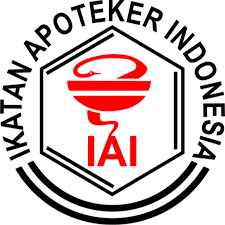Identifikasi Peptida Bioaktif dari Protein Kedelai sebagai Inhibitor Enzim α-glukosidase untuk Kandidat Antidiabetes
Taufik Muhammad Fakih(1*), Mentari Luthfika Dewi(2)(1) Program Studi Farmasi, Fakultas Matematika dan Ilmu Pengetahuan Alam, Universitas Islam Bandung
(2) Program Studi Farmasi, Fakultas Matematika dan Ilmu Pengetahuan Alam, Universitas Islam Bandung
(*) Corresponding Author
Abstract
Keywords
Full Text:
PDFReferences
Abuissa, H., Jones, P. G., Marso, S. P., and O’Keefe, J. H., 2005. Angiotensin‐converting enzyme inhibitors or angiotensin receptor blockers for prevention of type 2 diabetes: A meta‐analysis of randomized clinical trials. Journal of the American College of Cardiology, 46(5), pp.821-826.
Asmat, U., Abad, K., and Ismail, K., 2016. Diabetes mellitus and oxidative stress—A concise review. Saudi Pharmaceutical Journal, 24(5), pp.547-553.
Benalla, W., Bellahcen, S., and Bnouham, M., 2010. Antidiabetic Medicinal Plants as a Source of Alpha Glucosidase Inhibitors. Current Diabetes Reviews, 6(4), pp.247-254.
Blonde, L., 2012. Benefits and Risks for Intensive Glycemic Control in Patients With Diabetes Mellitus. The American Journal of the Medical Sciences, 343(1), pp.17-20.
Bolen, S., Feldman, L., Vassy, J., Wilson, L., and Yeh, H., 2019. Review Annals of Internal Medicine Systematic Review: Comparative Effectiveness and Safety of Oral Medications for Type 2 Diabetes Mellitus. Annals of Internal Medicine, 147(6), pp.386-399.
Drucker, D., 2007. Dipeptidyl peptidase-4 inhibition and the treatment of type 2 Diabetes. Diabetes Care, 30(6), pp.1335-1343.
Johnson, M. H., Lucius, A., Meyer, T., and Gonzalez De Mejia, E., 2011. Cultivar evaluation and effect of fermentation on antioxidant capacity and in vitro inhibition of α-amylase and α-glucosidase by highbush blueberry (Vaccinium corymbosum). Journal of Agricultural and Food Chemistry, 59(16), pp.8923-8930.
Lee, J.E., Min, S.H., Lee, D.H., Oh, T.J., Kim, K.M., Moon, J.H., and Lim, S, 2016. Comprehensive assessment of lipoprotein subfraction profiles according to glucose metabolism status, and association with insulin resistance in subjects with early-stage impaired glucose metabolism. International Journal of Cardiology, 225, pp.327-331.
Kemmish, H., Fasnacht, M., and Yan, L., 2017. Fully automated antibody structure prediction using BIOVIA tools: Validation study. PLoS One, 12, e0177923.
Koopman, R., Crombach, N., Gijsen, A. P., Walrand, S., Fauquant, J., Kies, A. K., and van Loon, L. J. C., 2009. Ingestion of a protein hydrolysate is accompanied by an accelerated in vivo digestion and absorption rate when compared with its intact protein. American Journal of Clinical Nutrition, 90(1), pp.106-115.
Kurniawan, F., Miura, Y., Kartasasmita, R.E., Yoshioka, N., Mutalib, A., and Tjahjono, D.H., 2018. In silico study, synthesis, and cytotoxic activities of porphyrin derivatives. Pharmaceuticals, 11, 8.
Matsui, T., Yoshimoto, C., Osajima, K., Oki, T., and Osajima, Y., 1996. In vitro survey of α -glucosidase inhibitory food components. Bioscience, Biotechnology, and Biochemistry, 60(12), pp.2019-2022.
Nasri, R., Abdelhedi, O., Jemil, I., Daoued, I., Hamden, K., Kallel, C., and Karra‐Châabouni, M., 2015. Ameliorating effects of goby fish protein hydrolysates on high-fat-high-fructose diet-induced hyperglycemia, oxidative stress and deterioration of kidney function in rats. Chemico‐Biological Interactions, 242, pp.71-80.
Norel, R., Sheinerman, F., Petrey, D., and Honig, B., 2001. Electrostatic contributions to protein–protein interactions: Fast energetic filters for docking and their physical basis. Protein Sciences, 10(11), pp.2147-2161.
Qaseem, A., Barry, M. J., Humphrey, L. L., Forciea, M. A., Fitterman, N., Boyd, C., and Wilt, T. J., 2017. Oral pharmacologic treatment of type 2 diabetes mellitus: A clinical practice guideline update from the American college of physicians. Annals of Internal Medicine, 166(4), pp.279-290.
Rauf, M.A., Zubair, S., and Azhar, A., 2015. Ligand docking and binding site analysis with pymol and autodock/vina. International Journal of Basic and Applied Sciences, 4(2), pp.168-177.
Ren, Y., Liang, K., Jin, Y., Zhang, M., Chen, Y., Wu, H., and Lai, F., 2016. Identification and characterization of two novel α-glucosidase inhibitory oligopeptides from hemp (Cannabis sativa L.) seed protein. Journal of Functional Foods, 26, pp.439-450.
Seeliger, D., Groot, B.L., and De Pymol, V., 2010. Ligand docking and binding site analysis with PyMOL and Autodock/Vina. Journal of Computer-Aided Molecular Design. 24(5), pp.417-422.
Shen, Y., Maupetit, J., Derreumaux, P., and Tuffery, P., 2014. Improved PEP-FOLD approach for peptide and miniprotein structure prediction. Journal of Chemical Theory and Computation, 10(10), pp.4745-4758.
Tagami, T., Yamashita, K., Okuyama, M., Mori, H., Yao, M., and Kimura, A., 2013. Molecular basis for the recognition of long-chain substrates by plant & alpha-glucosidase. Journal of Biological Chemistry, 288(26), pp.19296-19303.
Veeraragavan, V., Narayanaswamy, R., and Chidambaram, R., 2017. Predicting the biodegradability nature of imidazole and its derivatives by modulating two histidine degradation enzymes (urocanase and formiminoglutamase) activities. Asian Journal Pharmaceutical and Clinical Research, 10(11), pp.383-386.
Wang, R., Zhao, H., Pan, X., Orfila, C., Lu, W., and Ma, Y., 2019. Preparation of bioactive peptides with antidiabetic, antihypertensive, and antioxidant activities and identification of α-glucosidase inhibitory peptides from soy protein. Food Science and Nutrition. 7(5), pp.1848-1856.
Zafar, M., Khan, H., Rauf, A., Khan, A., and Lodhi, M.A., 2016. In Silico study of alkaloids as α-glucosidase inhibitors: Hope for the Discovery of effective lead compounds. Frontiers in Endocrinology, 7, 153.
Zambrowicz, A., Pokora, M., Setner, B., Dąbrowska, A., Szołtysik, M., Babij, K., and Chrzanowska, J., 2015. Multifunctional peptides derived from an egg yolk protein hydrolysate: Isolation and characterization. Amino Acids, 47(2), pp.369-380.
Zhou, P., Jin, B., Li, H., and Huang, S.Y., 2018. HPEPDOCK: a web server for blind peptide-protein docking based on a hierarchical algorithm. Nucleic Acids Research, 46(1), pp.443-450.
Zhou, P., Li, B., Yan, Y., Jin, B., Wang, L., and Huang, S.Y., 2018. Hierarchical Flexible Peptide Docking by Conformer Generation and Ensemble Docking of Peptides. Journal of Chemical Information and Modeling, 58(6), pp.1292-1302.
Article Metrics
Abstract view(s): 1471 time(s)PDF: 1448 time(s)
Refbacks
- There are currently no refbacks.








